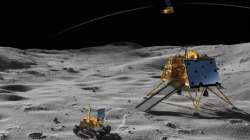NASA's Deep Space Network beaming radio frequency to Lander Vikram
NASA's Jet Propulsion Laboratory (JPL) is sending radio signals to Chandrayaan-2 Vikram Lander to help ISRO establish communication. NASA's Deep Space Network has been beaming radio frequency to Vikram Lander.

Of course, India is leaving no stone unturned to establish communication with Chandrayaan-2 Vikram Lander that went silent on September 7 during the moon mission. ISRO is doing its level best to strike contact with Vikram Lander that it has spotted on the lunar surface. ISRO is making efforts to establish link with Vikram lander via Indian Deep Space Network (IDSN) at Byalalu near Bengaluru. NASA's Jet Propulsion Laboratory (JPL) too has joined in to help the Indian Space Research Organisation.
How is NASA helping ISRO in its quest to communicate with Vikram Lander:
The National Aeronautics and Space Administration's Jet Propulsion Laboratory (JPL) is sending radio signals to Vikram Lander to help ISRO establish communication. According to astronomer Scott Tilley, who found American weather satellite IMAGE in 2018 that was believed to be lost, said NASA's Deep Space Network (DSN) has been beaming radio frequency to Vikram Lander. He said his station will continue to monitor for signals from Chandrayaan-2 Vikram Lander as long as NASA's Deep Space Network (DSN) continues to search for it. He further said that chances of his amateur station hearing a potential signal from Chandrayaan-2 Vikram Lander are slim.
Meanwhile, US space agency's DSN operator Richard Stephenson too confirmed that the network is helping secure a communication link with Vikram Lander.
What is NASA's Deep Space Network?
NASA's Deep Space Network is said to be the largest and most sensitive scientific telecommunications system in the world. NASA's international array of giant radio antennas, the Deep Space Network, DSN, supports interplanetary spacecraft missions and a few that orbit Earth. The Deep Space Network is operated by NASA's Jet Propulsion Laboratory (JPL) which also operates many of the agency's interplanetary robotic space missions.
NASA's Deep Space Network provides radar and radio astronomy observations that improve our understanding of the solar system and the larger universe. The antennas of the Deep Space Network are the indispensable link to explorers venturing beyond Earth. They provide the crucial connection for commanding our spacecraft and receiving their never before seen images and scientific information on Earth.
ALSO READ | Why ISRO will have to meet Sept 21 deadline to establish contact with Vikram Lander
ALSO READ | Calling Vikram: NASA joins ISRO to track Lander